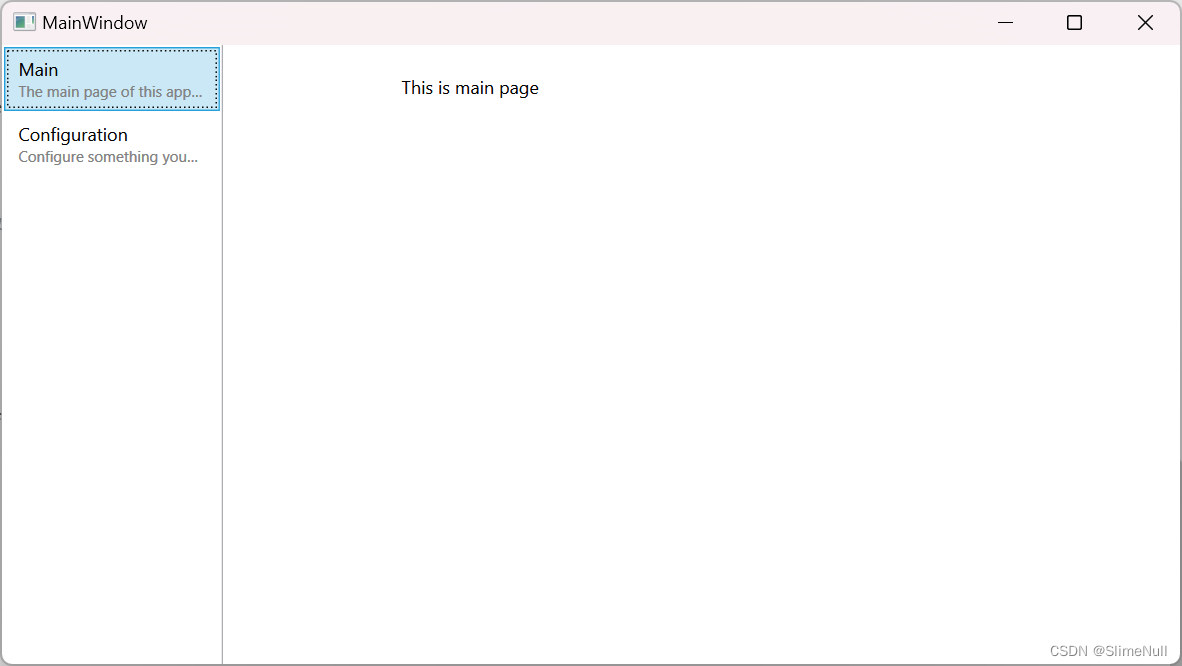多页面程序是一种很常见的设计, 一个程序中有多个页面, 然后直接切换页面而不需要创建新的窗口, WPF 中使用 Frame 来做页面跳转, 但是如何优雅的设计一个多页面程序, 这是个问题.
最基本的页面跳转
编写一个最基本的页面跳转, 首先我们需要在主窗口中放一个 Frame 控件, 然后再编写两个 Page. 下面我们以两个页面 MainPage 和 Configuration 作为示例讲解.
<!--窗口 UI-->
<Window x:Class="WpfNavigationTutorial.MainWindow"
xmlns="http://schemas.microsoft.com/winfx/2006/xaml/presentation"
xmlns:x="http://schemas.microsoft.com/winfx/2006/xaml"
xmlns:d="http://schemas.microsoft.com/expression/blend/2008"
xmlns:mc="http://schemas.openxmlformats.org/markup-compatibility/2006"
xmlns:local="clr-namespace:WpfNavigationTutorial"
xmlns:pages="clr-namespace:WpfTutorial.Views.Pages"
mc:Ignorable="d"
Title="MainWindow" Height="450" Width="800">
<Grid>
<Grid.ColumnDefinitions>
<ColumnDefinition Width="3*"/>
<ColumnDefinition Width="13*"/>
</Grid.ColumnDefinitions>
<ListBox Name="navMenu" SelectionChanged="ListBox_SelectionChanged">
<ListBoxItem Content="Main" Tag="{x:Type pages:MainPage}"/>
<ListBoxItem Content="Configuration" Tag="{x:Type pages:ConfigurationPage}"/>
</ListBox>
<Frame Grid.Column="1" Name="appFrame" NavigationUIVisibility="Hidden"/>
</Grid>
</Window>
在上面的代码中, 我们使用了一个左右两栏布局, 左侧放了一个 ListBox, 右侧放了一个 Frame, 在 ListBox 中, 我们放了两个 ListBoxItem, 使用 Content 做内容, 并且给加了 Tag 标识这个按钮具体要跳转到哪个页面.
然后在两个页面中分别这么简单写一下内容:
<!--这里是主页面-->
<Page x:Class="WpfTutorial.Views.Pages.MainPage"
xmlns="http://schemas.microsoft.com/winfx/2006/xaml/presentation"
xmlns:x="http://schemas.microsoft.com/winfx/2006/xaml"
xmlns:mc="http://schemas.openxmlformats.org/markup-compatibility/2006"
xmlns:d="http://schemas.microsoft.com/expression/blend/2008"
xmlns:local="clr-namespace:WpfTutorial.Views.Pages"
mc:Ignorable="d" d:DesignHeight="450" d:DesignWidth="800"
Title="MainPage">
<Grid>
<Grid MaxWidth="400" Margin="20">
<StackPanel HorizontalAlignment="Stretch">
<TextBlock>This is main page</TextBlock>
</StackPanel>
</Grid>
</Grid>
</Page>
<!--这里是里一个页面页面 (配置页面)-->
<Page x:Class="WpfTutorial.Views.Pages.ConfigurationPage"
xmlns="http://schemas.microsoft.com/winfx/2006/xaml/presentation"
xmlns:x="http://schemas.microsoft.com/winfx/2006/xaml"
xmlns:mc="http://schemas.openxmlformats.org/markup-compatibility/2006"
xmlns:d="http://schemas.microsoft.com/expression/blend/2008"
xmlns:local="clr-namespace:WpfTutorial.Views.Pages"
mc:Ignorable="d" d:DesignHeight="450" d:DesignWidth="800"
Title="ConfigurationPage">
<Grid>
<Grid MaxWidth="400" Margin="20">
<StackPanel HorizontalAlignment="Stretch">
<TextBlock>This is configuration page</TextBlock>
</StackPanel>
</Grid>
</Grid>
</Page>
在后台代码中, 我们这么写, 当选择项变更的时候, 也使用 Frame 进行页面跳转.
public partial class MainWindow : Window
{
public MainWindow()
{
InitializeComponent();
}
// 页面实例的缓存
private static readonly Dictionary<Type, Page> bufferedPages =
new Dictionary<Type, Page>();
// 当
private void ListBox_SelectionChanged(object sender, SelectionChangedEventArgs e)
{
// 如果选择项不是 ListBoxItem, 则返回
if (navMenu.SelectedItem is not ListBoxItem item)
return;
// 如果 Tag 不是一个类型, 则返回
if (item.Tag is not Type type)
return;
// 如果页面缓存中找不到页面, 则创建一个新的页面并存入
if (!bufferedPages.TryGetValue(type, out Page? page))
page = bufferedPages[type] =
Activator.CreateInstance(type) as Page ?? throw new Exception("this would never happen");
// 使用 Frame 进行导航.
appFrame.Navigate(page);
}
}
最后的效果就是这样, 点击左侧项目的时候, 右侧页面会直接进行跳转:

加一点美化
用 ListBox 做侧边页面栏就太丑了, 我们可以使用 ListBox 自己给它套一个样式.
这里不使用
ItemsControl是因为,ListBox的项目是 “可选中” 的, 而ItemsControl是没有的,ItemsControl只适合界面控件的批量绑定生成.
创建一个 NavigationItem 用来存放导航数据:
public class NavigationItem
{
/// <summary>
/// 导航标题
/// </summary>
public string Title {
get; set; } = string.Empty;
/// <summary>
/// 导航描述
/// </summary>
public string Description {
get; set; } = string.Empty;
/// <summary>
/// 目标页面的类型
/// </summary>
public Type TargetPageType {
get; set; } = typeof(Page);
}
为 MainWindow 创建一个 MainWindowModel 用来存放页面数据:
public class MainWndowModel
{
public ObservableCollection<NavigationItem> NavigationItems {
get; } =
new ObservableCollection<NavigationItem>()
{
new NavigationItem()
{
Title = "Main",
Description = "The main page of this application",
TargetPageType = typeof(MainPage)
},
new NavigationItem()
{
Title = "Configuration",
Description = "Configure something you want",
TargetPageType = typeof(ConfigurationPage)
}
};
}
然后将主页面的代码改成这样:
<Window x:Class="WpfNavigationTutorial.MainWindow"
xmlns="http://schemas.microsoft.com/winfx/2006/xaml/presentation"
xmlns:x="http://schemas.microsoft.com/winfx/2006/xaml"
xmlns:d="http://schemas.microsoft.com/expression/blend/2008"
xmlns:mc="http://schemas.openxmlformats.org/markup-compatibility/2006"
xmlns:local="clr-namespace:WpfNavigationTutorial"
xmlns:pages="clr-namespace:WpfTutorial.Views.Pages"
xmlns:vm="clr-namespace:WpfNavigationTutorial.ViewModels"
mc:Ignorable="d"
Title="MainWindow" Height="450" Width="800">
<Window.DataContext>
<!--直接在 XAML 中给 Window 的 DataContext 赋值-->
<vm:MainWndowModel/>
</Window.DataContext>
<Grid>
<Grid.ColumnDefinitions>
<ColumnDefinition Width="3*"/>
<ColumnDefinition Width="13*"/>
</Grid.ColumnDefinitions>
<!--使用 ListBox, 并且将 ItemsSource 绑定到我们的数据-->
<!--记得要使用禁用它的水平滚动条-->
<ListBox Name="navMenu"
ItemsSource="{Binding NavigationItems}" BorderThickness="0 0 1 0"
ScrollViewer.HorizontalScrollBarVisibility="Disabled"
SelectionChanged="navMenu_SelectionChanged">
<ListBox.ItemTemplate>
<DataTemplate>
<Border Padding="5">
<StackPanel>
<TextBlock Text="{Binding Title}"/>
<!--描述信息用灰色字体, 字号也小一点, 多余的部分剪切掉-->
<TextBlock Text="{Binding Description}" Foreground="Gray"
FontSize="10" TextTrimming="CharacterEllipsis"/>
</StackPanel>
</Border>
</DataTemplate>
</ListBox.ItemTemplate>
</ListBox>
<Frame Grid.Column="1" Name="appFrame" NavigationUIVisibility="Hidden"/>
</Grid>
</Window>
后台代码也相应的改一下, 只需要判断数据是否是 NavigationItem 就好:
public partial class MainWindow : Window
{
public MainWindow()
{
InitializeComponent();
}
private static readonly Dictionary<Type, Page> bufferedPages =
new Dictionary<Type, Page>();
private void navMenu_SelectionChanged(object sender, SelectionChangedEventArgs e)
{
// 如果选择项不是 FrameworkElement, 则返回
if (navMenu.SelectedItem is not NavigationItem item)
return;
Type type =
item.TargetPageType;
// 如果页面缓存中找不到页面, 则创建一个新的页面并存入
if (!bufferedPages.TryGetValue(type, out Page? page))
page = bufferedPages[type] =
Activator.CreateInstance(type) as Page ?? throw new Exception("this would never happen");
appFrame.Navigate(page);
}
}
最后的效果:

当然, 这样的效果还是很简单, 不过, 更复杂的设计, 就任由你自己发挥啦. 例如改掉
ListBox元素被选中时的丑陋颜色, 以及去掉聚集焦点时的虚线, 或者加一些动画, 都可以.